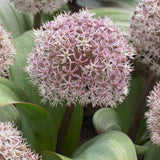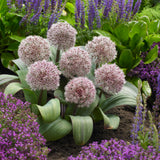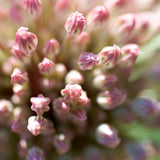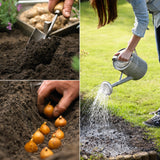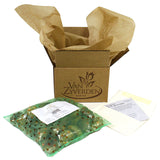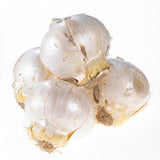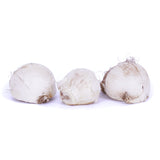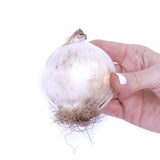PRESALE
Refer to the Fall 2024 Shipping Schedule Map Below
Ornamental allium are just a small part of a large genus of over 400 species of mostly onion scented herbs that includes the common onion, leek, garlic, chive and shallot. This makes gardeners wonder if they should include them in their ornamental gardening plans since it conjures up images of supermarket produce. Allium blooms create high drama and interest in the garden and range in color from white, yellow, pink to purple, few to a great many, always in a ball shape of loose or tight, sparse or dense flower clusters. The leaves of only a few smell like onions - normally only when bruised. With over 300 species to choose from, the allium group is a popular choice for the spring garden.
About this Variety
Allium karataviense is a compact, bulbous perennial that is ornamentally grown for both its foliage and its flowers. It is native to the Karatau Mountains (hence the specific epithet) in Kazakhstan. Broad-elliptic, spreading, gray-green, basal leaves appear in pairs. Leaves are sometimes mottled with purple. In late spring, a short but sturdy flowering stem rises from the center of each leaf pair. Each flowering stem is topped with a large spherical flower head containing tiny, star-shaped, dull pink florets. Flowers have a mild fragrance.
Highlights
- Deer & critter resistant
- Beneficial to pollinators; Attracts butterflies
- Excellent for cut flowers & perfect for drying
- Drought tolerant & easy to grow
- Grows well in containers, borders, rock gardens & mass plantings; Provides winter interest after blooming
Exposure:
Full Sun
Blooms:
Late Spring to Early Summer
Height:
Grows 6-12" tall
Spacing/Depth:
Plant 6-8" apart, 4-8" deep
USDA Zones:
Grow as Perennial in zones 5-8. Grow as Annual elsewhere.
Growing Instructions
Plant in the fall, before the first frost hardens the soil. Dig a hole to the required depth. Place bulb in hole, pointed side up. Cover with soil and water thoroughly. Mulch in extreme climates. For container planting, bury the bulb three times as deep as the bulb is wide. In zones 6 and below, you will need to protect your bulb containers. Place them near the foundation of the house or other structure. In zones 3-5, place the container in an unheated garage or shed. After blooming, leave the bulbs in place so plants can clump or reseed. Divide only when containers or planting spaces become too crowded. Propagate in the fall by division after they have been chilled for four weeks in a moist medium.
Care Tip
Allium does not like 'wet feet'. Be sure to plant in a sunny location where the soil drains well. The bulbs will rot in wet areas. Dig, divide and replant bulbs after a few years of decreasing flower production.











